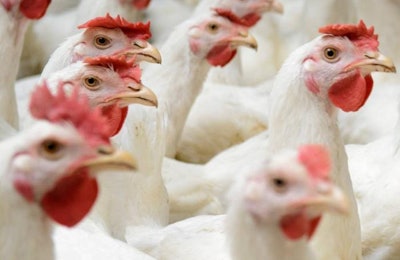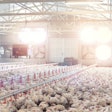
Further strengthening animal welfare standards in England is the aim of two new measures proposed by the government covering closed circuit television (CCTV) monitoring in slaughterhouses, and an updated code of practice for the welfare of broilers and broiler breeders.
The proposals, made by the Department for the Environment, Food and Rural Affairs (Defra), are now open for consultation.
“As we prepare to leave the EU, these measures provide a further demonstration to consumers around the world that our food is produced to the very highest standards,” said Environment Secretary, Michael Gove at the launch of the latest initiatives.
The measures will apply in England, but not in the devolved UK regions, Scotland, Wales and Northern Ireland.
CCTV monitoring in slaughterhouses
Defra is proposing to make CCTV equipment mandatory in areas where live animals are handled in every slaughterhouse in England, and veterinary officials from the Food Standards Agency (FSA) will be allowed unrestricted access to this material.
Oversight by trained vets will ensure that the welfare of the animals is maintained throughout their time in the slaughterhouse. If standards are missed, a range of possible penalties includes a welfare enforcement notice, the suspension or revocation of staff licenses, or referral for a criminal investigation.
The proposal has generally been welcomed by farming and food bodies.
“British farming is fully committed to high levels of animal welfare and the NFU expects this to continue once livestock leave the farm,” said Charles Sercombe, the National Farmers Union (NFU) Livestock Board chairman. “The NFU welcomes mandatory CCTV monitoring in all UK abattoirs as maintaining public confidence of our great British product is incredibly important.”
The British Veterinary Association (BVA) also welcomed the announcement.
“We recognize that the cost of installing CCTV may be a burden for some very small abattoirs, but it is important that the animals we farm for food have both a good life and a humane death and CCTV has a key role to play in ensuring these requirements are met,” said BVA President Gudrun Ravetz.
Animal welfare campaign organization, Compassion in World Farming, is also supporting Defra’s proposal.
“Millions of animals each year are at risk of suffering behind the closed doors of slaughterhouses,” said Emma Slawinski, its Director of Campaigns. “Up until now, CCTV has been a voluntary decision, however mandatory CCTV in slaughterhouses will provide the crucial transparency to ensure that legal protections are not being flouted.”
The consultation period for this proposal is open until September 22, 2017.
Updated welfare code for meat chickens
Defra has also confirmed a review of the the statutory welfare standards for farm animals and domestic pets in England in the light of the latest innovations, technology, and veterinary advice. First to be updated will be the Code of Practice for the Welfare of Meat Chickens and Meat Breeding Chickens.
The current code was published in 2002, and does not cover the latest rules that have been in place since 2010.
On behalf of the BVA, Ravetz welcomed the consultation to update the welfare codes.
“The British Veterinary Poultry Association are committed to supporting research and implementation of best practice in all aspects of poultry production, including welfare on farm and in the abattoir,” said John Tasker for the Association (BVPA). “We look forward to cooperating fully with Defra in development and implementation of these new initiatives. The British poultry industry has some of the highest welfare standards in the world and seeks to continually update and refine its practices in the light of new research, and to maintain public confidence in the industry.”
Among the topics covered in the 142 paragraphs in the proposed Code is one on beak trimming.
It states: “It is not usually necessary to beak trim female breeding and grandparent chicks routinely. For male breeding and grandparent chicks, beak trimming may be more appropriate to prevent injury to other birds from aggressive or injurious pecking. If so, only the tip of the beak should be removed from these chicks. This should be done before 10 days of age, preferably at day old using infra-red technology. Beak trimming of older birds should only be carried out in an emergency when advised by a veterinary surgeon.”
Consultation on the proposed Code of Practice closes on October 6.

















